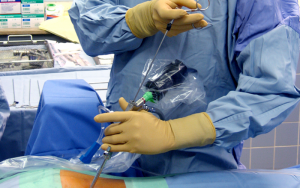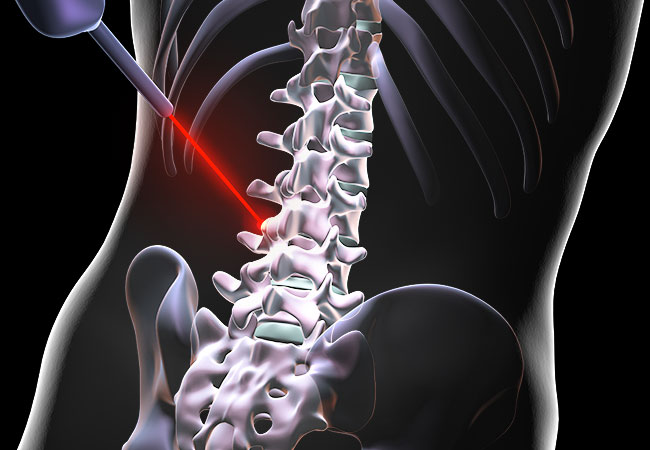Endoscopic laser disc surgery: Laser Spine Disc Surgery is a minimally invasive surgical technique of the spine, in which an endoscope or needle is used for the treatment of lumbar disc herniations (protruding, extruded or degenerated discs), which have not had a response to medical management and cause neurological symptomatology. The endoscope is the access key for the surgeon to remove a herniated disc.
The procedure
The surgical time is approximately 30 minutes for each disc. An incision of approximately 2 cm is made in the posterolateral part of the lower back. To calculate the endoscope entry site, three-dimensional measurements are made, with the support of transoperative fluoroscopy.
 The procedure is performed with sedation and local anaesthesia so that the patient is calm. However, the patient must be awake, to perform the provocative discography, and thus reproduce the previous pain and ensure that his problem will be solved by identifying the exact site cause of pain. Subsequently, by fluoroscopy, the placement of instruments is continued, after introducing a metal guide, a dilator is passed, until reaching the so-called triangular zone (the work area), between the exit of the nerves. The disc is penetrated with the shutter and then with a trephine. Here, if there is unusual pain, the outer part of the disc and nerve should be explored to rule out any abnormalities in the nerve root, and even the inflammatory membrane, which gives sensitivity to the fibrous ring often causing pain. These anomalies are not seen in the NMR studies, thus eliminating the cause of pain, this part of the procedure should be performed with laser assistance. Later a cannula is introduced through the obturator, and that will finally be the working channel where the endoscope and surgical instruments are introduced. The nerve root is protected with the same cannula. Resection of the disc will depend on the type of hernia. The endoscope has an irrigation suction system, similar to knee arthroscopy. Here the bipolar and the laser help us to control bleeding, we remove the tissue from the disc, the ring defect narrows or closes, removes the inflammatory and granulation tissue. Among the fibres in the ring, painful fibers are removed by laser.
The procedure is performed with sedation and local anaesthesia so that the patient is calm. However, the patient must be awake, to perform the provocative discography, and thus reproduce the previous pain and ensure that his problem will be solved by identifying the exact site cause of pain. Subsequently, by fluoroscopy, the placement of instruments is continued, after introducing a metal guide, a dilator is passed, until reaching the so-called triangular zone (the work area), between the exit of the nerves. The disc is penetrated with the shutter and then with a trephine. Here, if there is unusual pain, the outer part of the disc and nerve should be explored to rule out any abnormalities in the nerve root, and even the inflammatory membrane, which gives sensitivity to the fibrous ring often causing pain. These anomalies are not seen in the NMR studies, thus eliminating the cause of pain, this part of the procedure should be performed with laser assistance. Later a cannula is introduced through the obturator, and that will finally be the working channel where the endoscope and surgical instruments are introduced. The nerve root is protected with the same cannula. Resection of the disc will depend on the type of hernia. The endoscope has an irrigation suction system, similar to knee arthroscopy. Here the bipolar and the laser help us to control bleeding, we remove the tissue from the disc, the ring defect narrows or closes, removes the inflammatory and granulation tissue. Among the fibres in the ring, painful fibers are removed by laser.
In certain cases a bi portal approach is used, that means, on both sides of the spine. Sometimes the fragment of the disk leaves the ring and it is not possible to resect by endoscopy and you will need to have another procedure of the conventional type. This can happens in approximately 10% of affected segments.
The nerve root foramen where the nerve exits the spine can be visualized by endoscopy (it is not possible to have that visualization by traditional procedures) and therefore foraminal or lateral stenosis can be treated surgically by this procedure. This surgery is ambulatory, that means that the patient does not require hospitalization. At the end of the procedure the patient can go home.
How is Endoscopic laser disc surgery performed?

